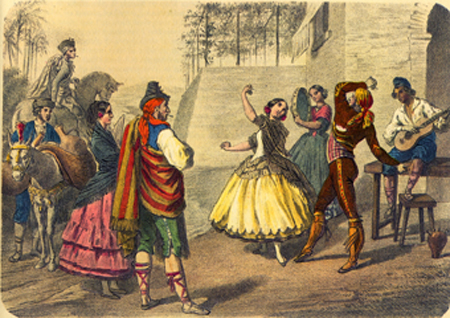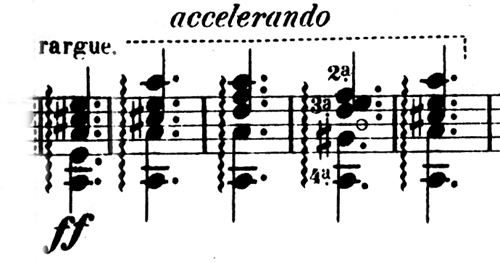Juan Parga
"the missing link"
The Chanterelle Editions always surprise us. What! Another nineteenth century guitarist to discover? Another totally unknown? In addition, a man who "fills the void in the popular-classical Spanish music between Arcas and composers of the early twentieth century as Falla and Turina," as stated by the editor? A sumptuous engraving, impeccable facsimile, fingering a merciless precision and abundance? Too much.
Juan Parga (1843-1899) was known only by its entry in the Prat's Dictionary of Guitarists. Philip Bone does not even mention him. In short, he had simply disappeared from the collective memory. And yet ...
The works published during his lifetime by Parga which have survived are divided into three parts:
- The "Andalusian repertoire taken from the people and technically easy" op 2, 5, 9, 11, 12, obviously not intended for the concert;
- Three concert Rhapsodies op 10, 25, and 64; Two Fantasies op 29 and 30; op 7 and 13 in the same vein as the Rhapsodies but shorter. All these compositions use the deep Andalusian language but in a rather classic formal mold.
- The Mazurkas, Op 23 Tangos Fantasticos an elegiac Nocturne Op 24 and Op 28 Concierto Clásico in the usual style of the other guitarists of the time
[i]
.
Most likely, we will certainly find innumerable faults in the music ofParga [ii] . But it contains two unique qualities, both permanent values: the invention, and a guitar break with average production and conventional language of his time.
The guitar of Parga
With Parga, we have for the first time a truly guitar design, so modern writing - the more idiosyncratic use of the instrument and not a more or less successful adaptation of language of other instruments of the orchestra
[iii]
.
The tyranny of classical accompanied melody here often gives way to a more typical guitar writing where harmony and "melody", blent one inside the other, are redistributed as arpeggios reminiscent of lute "style brisé" (eg. op 4, page 7 lines 2,3,4
The melodic interest is more often in the bass (the best acoustically!). If Sor (Fantaisie Elégiaque) and Regondi (Reverie) preceded in this path - Parga goes beyond his models: he uses the lower strings in high positions as melodic elements, harmony beeing sometimes arpeggiated and being processed as "campanelle" (op 29, pages 10/11). -
In general, he uses high positions as a result of a logic of harmonious movements of the left hand along the string. This is a true ergonomic fingering that promotes also the natural expression (see op 6, p. 4, 5 and especially op 25)
[iv]
If Parga perpetuates the "gadgets" of the Romantics (imitation of instruments, melodies in harmonics, left hand alone playing, etc.) he regularly adds two new features: percussion and various rasgueados. These techniques are of course inseparable from the flamenco guitar, but the merit of Parga is having integrated them not only to his Andalusian works but even to those of the "European" line. See for example the final rasgueado of Concierto Clásico and emotional and funereal effect of Tambora early Op 24. This is also the first time I've seen written crossing fingers of the left hand, double trills accompanied by harmonics, etc. Modern is also the concept that the fingerings are closely related to phrasing and interpretation in general. It then becomes imperative to note them precisely if we want to communicate a "manner", a way of saying the music that would not appear at reading simple notes. I think especially to Andalusian music, so "special" to theforeign. Hence the avalanche of fingerings and also dynamics and agogics in the scores of Parga. In short, a guitarist is confronted for the first time to the problem of communicating a guitar gesture.
The style
If in his classical manner, Parga shows prisoner of writing tics of other guitarists of his century - while revealing superior in regard to the form (often released with his rivals, especially in long pieces), however in Andalusian concert works, he demonstrates originality and unparalleled imagination.
While Europe still loiters in the tonal system and its conventions, or manages timidly some exotic modes, Parga follows and exceeds his master Arcas
[v]
and built without complex large frescoes on the Andalusian mode.
To fully grasp the value and daring of this approach, we must see that Albéniz at the same time still seems hesitant to use these scales, these cadences and rhythms of "cante jondo", too connotated and "popular" for Spain and "barbaric" [vi] for almost all scholars musicians : Rumores de la Caleta and Asturias are exceptions in the abundant but conventional production of this first "romantic" Albéniz. Besides, Asturias, as well as works of Parga himself, ends on a "false" perfect cadence in pure tonal style as to erase too long away from the norm. At the same time, the few "hispanic" works of other guitarists like Tárrega, far from flirting with the modality, are part of a strictly tonal style and archiclassic form, like the famous Spanish Dances by Sarasate for violin. While other write polkas and serenades, Parga is already exploring concepts such as rhythm pedal (this is the first precise notation to my knowledge of the traditional 3/4 + 3/8 + 3/8) and also the amalgama compass of - in his words - 3/4 + 2/4. To preserve the strength and obsessive incantation of modality, Parga voluntarily restricted the modulations in the Andalusian Rhapsodies nevertheless he demonstrated great skill in architecture in the classical style (see op. 28); he limited himself to short and striking dissonant digressions (op. 13, page 3, page 5, or 1.2 litters, litter 1). Regarding harmony, he is also respectful of tradition, even if he has sometimes unexpected boldness as the chord, G sharp, D, E, F, Op. 4 page 3, line 8, mes. 3.
Unfortunately, the harmonic rules of flamenco, though tasty, are restricted and follow sequences that have become long in our ears, clichés. Parga, apparently, does not want, shoving that framework; he is not a creator but a "re-creator." He expressed himself on the subject of the rlation of his art with folklore: to a former student fell into the fiamencomania, he writes that he wants from flamenco only its poetic essence: "I do what we do with the Lemon, I take the juice and throw the bark. " Nevertheless, one is obliged to note that this sublimation, Parga only realizes a little, because of lack of technique or by his too great respect for popular tradition. Does not he uses to describe the "Andalusian repertoire taken from the people," for the fans, with the adjective "authentic"? Already purists!
This concern of casticismo, authenticity, Parga is to pay with a perverse effect : predictability. Predictability for sentences even beautiful ones, and especially the cadenzas formulas unsurprisingly; style from which do not escape authors like R. Sainz de la Maza or Pujol who continued to use them even much later . It is not easy to be Falla or Turina.
This reissue requires some reflection: first, that the past of the guitar is being written and that we should not be surprised at anything; that Parga's music is hard - it is a travel both in time and in space - but that its value is certain, if only that of a "flashback" on time of flamenco cantantes cafes. This music casts a curious light on Matanya Ophee phrase: "The Segovia phenomenon is grafted on a wide popular guitar activity before 1920. He was simply a better performer and more charismatic than his predecessors".
[vii]
.
In any case, a guitarist and not the least did not disdain to play Parga: on July 25, 1939, in a program where you could find the names of Turina and Granados was Agustin Barrios playing in concert the Polo y Soleà (op.4) in San Salvador (Costa Rica)!
[viii]
.
R.A.
(published in 1993 in the Cahiers de la guitare)
[i] For the first issue, Chanterelle verlag gives us the op. 2, 4, 5, 6, 13, 23, 24, 30.
[ii] See Cahiers de la Guitare n°41, january 1992, page 52.
[iii] Falla had this clear vision of the fate of the guitar, too often considered as part of the panoply of romanticism. He said: "No, not at all The" Romantic Era was the very one where the guitar was low It was used to play the same music as the other instruments. But it was not really suited to the music of the nineteenth century, and so it sank. She returned now, because it is particularly suitable for modern music
[iv] This match is quite characteristic of popular guitars like flamenco, but knowledge of the possibilities of the dice that goes round - ancient flamenquistes as Ramón Montoya for example.
[v] See for exemple works by Arcas published by UME : Murcianas 1078, Rondeña 1082, Soleà 084.
[vi] Asked about the flamenco guitar the agreements, which some describe as "barbarians," Falla says, "... wonderful revelation of harmonic possibilities hitherto undreamed!" And demonstrate how we find the influence of the specific modal and harmonic organization guitar for Domenico Scarlatti to the Debussy Quartet Scherzo
[vii] Il Fronimo n°40 page 36
[viii] Richard Stover, Il Fronimo n° 20

